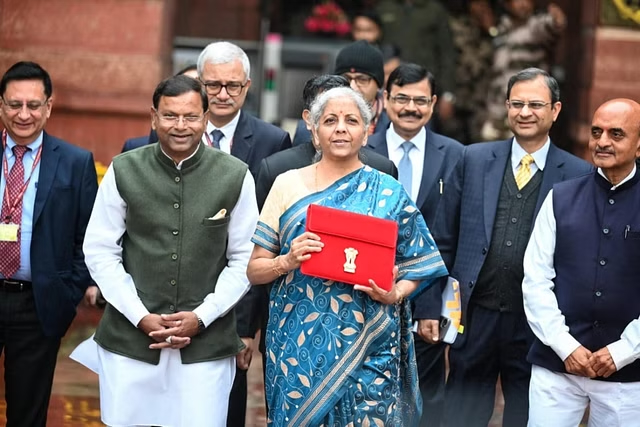Finance Minister Nirmala Sitharaman Charts a Course for Viksit Bharat Amidst Global Challenges
New Delhi, NFAPost: In a defining moment for India’s economic trajectory, Finance Minister Smt. Nirmala Sitharaman presented the Interim Union Budget for the fiscal year 2024-25 in Parliament. The budget, laden with strategic allocations and visionary goals, underscores the government’s commitment to fostering comprehensive and inclusive development. Let’s unravel the intricacies of this budget that promises to shape India’s future.
Economic Outlook and Growth Projections
The Finance Minister commenced her address by shedding light on India’s economic resilience, as projected Real GDP is set to grow at an impressive 7.3% in the fiscal year 2023-24. This growth aligns with the upward revision by the RBI and showcases India’s ability to navigate global economic challenges. The IMF, in its World Economic Outlook, has bolstered confidence in India’s economic prowess, estimating it to become the third-largest economy by 2027.
Undoubtedly, the last ten years have witnessed a positive transformation in India’s economic landscape, with healthy macroeconomic fundamentals and robust growth. The Finance Minister emphasized the government’s commitment to ‘SabkakaSaath,’ targeting the empowerment of four major segments: the poor (‘Garib’), women (‘Mahilayen’), youth (‘Yuva’), and farmers (‘Annadata’).
Key Budget Highlights
Capital Expenditure Surge: A pivotal aspect of the budget is the 11.1% increase in the capital expenditure outlay to a staggering Rs 11,11,111 crore, constituting 3.4% of the GDP. This surge builds upon the substantial tripling of capital expenditure over the past four years, contributing significantly to economic growth and employment creation.
Focus on the Eastern Region: The government expressed its commitment to making the eastern region a potent driver of India’s growth. Specific strategies and high-powered committees will be formed to address challenges arising from fast population growth and demographic changes.
Interest-Free Loans for Development: A corpus of Rs 1 lakh crore will be established for a fifty-year interest-free loan, providing long-term financing to support research and innovation in sunrise domains. This move is expected to stimulate private sector involvement in critical areas.
Foreign Direct Investment (FDI) Milestone: India has witnessed a golden era in FDI, with an inflow of USD 596 billion from 2014-23, doubling the inflow during 2005-14. The government is actively negotiating bilateral investment treaties to further encourage sustained foreign investment.
People-Centric Development
The Finance Minister reiterated the government’s commitment to a development approach that is all-encompassing, targeting every household and individual. The transformative efforts in the last ten years have lifted 25 crore people from multi-dimensional poverty. Initiatives like the Pradhan Mantri Mudra Yojana have sanctioned 43 crore loans, empowering women entrepreneurs with 30 crore loans.
The Pradhan Mantri Kisan Sampada Yojana and Pradhan Mantri Formalisation of Micro Food Processing Enterprises Yojana have significantly benefited farmers and self-help groups, contributing to rural development.
Fiscal Consolidation and Taxation
The budget maintains continuity in taxation, with no proposed changes in tax rates. However, certain tax benefits for start-ups and investments made by sovereign wealth or pension funds have been extended by a year. An applaudable move is the withdrawal of outstanding direct tax demands, benefiting around one crore taxpayers.
Direct tax collections have seen a remarkable threefold increase over the last ten years, with a focus on improving tax-payer services. The return filers have surged 2.4 times, reflecting the success of simplified tax regimes and reduced corporate tax rates.
GST Impact and Indirect Taxes
The Goods and Services Tax (GST) has played a pivotal role in unifying India’s fragmented indirect tax regime, reducing the compliance burden on trade and industry. The tax base of GST has more than doubled, with monthly gross GST collections reaching Rs 1.66 lakh crore. The reduction in logistics costs and taxes has translated into lower prices for goods and services, directly benefiting consumers.
Customs facilitation measures, including decreased import release times, have further streamlined international trade processes.
Looking Ahead: A Viksit Bharat by 2047
The Finance Minister concluded her budget presentation by emphasizing the government’s vision for ‘Viksit Bharat’ by 2047. The pursuit of ‘SabkakaSaath’ has not only overcome challenges but has also laid the foundation for sustained high growth. A white paper on the status of the Indian economy will be released, offering insights into the nation’s journey from pre-2014 challenges to its current state of economic resilience.
The full budget, scheduled for July, promises to provide a detailed roadmap for achieving the vision of a developed India by 2047.
In essence, the Interim Union Budget for 2024-25 reflects a strategic and holistic approach to economic development, prioritizing the welfare of the marginalized and underscoring the government’s commitment to building a resilient and prosperous India.





